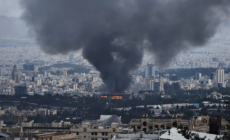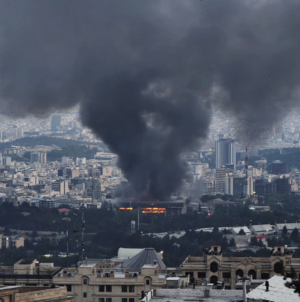-
Iran Says Nuclear Sites Evacuated Before US Strikes - 15 mins ago
-
With Decision to Bomb Iran, Trump Injects U.S. Into Middle East Conflict - 25 mins ago
-
B2s Dropped Six Bunker Busters on Iran’s Fordow, Fox Host Says Citing Trump - 51 mins ago
-
What to Know About the Israel-Iran Conflict as U.S. Joins War - about 1 hour ago
-
Dawn Staley Reveals Helpful Advice For Eagles’ Jalen Hurts - about 1 hour ago
-
Is Donald Trump an Antagonist or Champion of the Gay Community? - 2 hours ago
-
Donald Trump to Address Nation After Attacking Iran Nuclear Sites - 2 hours ago
-
Why Williams Just Bet Their Future on James Vowles – And Why It Matters - 3 hours ago
-
Right-Wing Violence Is Not a Fringe Issue - 3 hours ago
-
Sen. Padilla claps back after JD Vance calls him ‘Jose’: ‘He knows my name’ - 3 hours ago
Israel and Hamas Work on Final Details of Gaza Cease-Fire Deal, Officials Say
Mediators rushed on Wednesday to clinch a deal between Israel and Hamas on a cease-fire that would release hostages held in Gaza, after more than a year of devastating war that has killed tens of thousands of Palestinians and destroyed much of the enclave.
Neither Israel nor Hamas has publicly endorsed the agreement, and Israeli and U.S. officials have said that they were waiting for a final response from Hamas. The Palestinian group said on Tuesday that the negotiations had entered their “final stages.”
Negotiators and mediators in Qatar were attempting to address outstanding issues, according to two officials familiar with the matter, who spoke on condition of anonymity to discuss sensitive diplomacy.
Those issues included maps of how Israeli forces would redeploy inside Gaza during the cease-fire, as well as lists of Palestinian prisoners slated for release in exchange for Israeli and foreign hostages, one of the officials said.
Israel has also demanded a system to prevent armed fighters from returning to northern Gaza. Mediators are also trying to iron out details on inspections of the hundreds of thousands of displaced Palestinians who would be expected to head to northern Gaza from the south, where many have been displaced, in the event of a truce, the official said.
The latest round of talks is being held in Qatar, a key mediator alongside Egypt and the United States. Majed al-Ansari, the spokesman for the Qatari Foreign Ministry, said on Tuesday that the two sides had overcome major disagreements.
But in order to implement the deal, Hamas’s negotiating team in Doha must also obtain the consent of the group’s commanders in Gaza, including Mohammad Sinwar, whose brother Yahya led the group before being killed by Israel in October.
Hamas officials did not respond to questions about whether Mr. Sinwar had responded to the proposal.
In Israel, some hard-line members of Prime Minister Benjamin Netanyahu’s government have also voiced opposition to the deal. But on Wednesday, Gideon Saar, the Israeli foreign minister, said he believed that a majority would sign off on an agreement if it came to a vote in the cabinet.
Months of shuttle diplomacy have failed to end the war in Gaza, which began after Hamas launched a surprise attack on Israel on Oct. 7, 2023 that killed 1,200 people and saw 250 taken hostage. Around 105 captives were later released in a weeklong cease-fire in November 2023 in exchange for 240 Palestinian prisoners.
Israel and Hamas have since held numerous rounds of indirect talks, all of which ultimately collapsed amid mutual recriminations. Officials familiar with the negotiations have expressed cautious optimism while noting that there is always a chance that the discussions will founder.
The current deal is broadly similar to a three-phase cease-fire framework publicized by President Biden in late May, according to several officials familiar with the talks. Israel and Hamas would first observe a six-week cease-fire in which Hamas would release women, older men, and ill hostages in exchange for the release of Palestinians jailed by Israel.
Under that proposal, Israel and Hamas would then declare a “permanent cessation of hostilities,” Israeli forces would withdraw from Gaza and the remaining living hostages would be swapped for Palestinian prisoners. But the details have been a major point of contention: Hamas has demanded Israel commit to ending the war, which Israel has resisted.



















